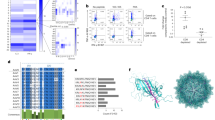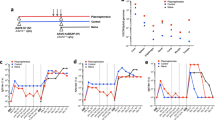Abstract
Activation of T cells to the capsid of adeno-associated virus (AAV) serotype 2 vectors has been implicated in liver toxicity in a recent human gene therapy trial of hemophilia B1. To further investigate this kind of toxicity, we evaluated T-cell responses to AAV capsids after intramuscular injection of vectors into mice and nonhuman primates. High levels of T cells specific to capsids of vectors based on AAV2 and a phylogenetically related AAV variant were detected. Vectors from other AAV clades2 such as AAV8 (ref. 3), however, did not lead to activation of capsid-specific T cells. Through the generation of AAV2-AAV8 hybrids and the creation of site-directed mutations, we mapped the domain that directs the activation of T cells to the RXXR motif on VP3, which was previously shown to confer binding of the virion to heparan sulfate proteoglycan (HSPG)4,5,6. Evaluation of natural and engineered AAV variants showed direct correlations between heparin binding, uptake into human dendritic cells (DCs) and activation of capsid-specific T cells. The role of heparin binding in the activation of CD8+ T cells may be useful in modulating the immunogenicity of antigens and improving the safety profile of existing AAV vectors for gene therapy.
This is a preview of subscription content, access via your institution
Access options
Subscribe to this journal
Receive 12 print issues and online access
$209.00 per year
only $17.42 per issue
Buy this article
- Purchase on Springer Link
- Instant access to full article PDF
Prices may be subject to local taxes which are calculated during checkout



Similar content being viewed by others
References
Manno, C.S. et al. Successful transduction of liver in hemophilia by AAV-Factor IX and limitations imposed by the host immune response. Nat. Med. 12, 342–347 (2006).
Gao, G. et al. Clades of Adeno-associated viruses are widely disseminated in human tissues. J. Virol. 78, 6381–6388 (2004).
Gao, G.P. et al. Novel adeno-associated viruses from rhesus monkeys as vectors for human gene therapy. Proc. Natl. Acad. Sci. USA 99, 11854–11859 (2002).
Summerford, C. & Samulski, R.J. Membrane-associated heparan sulfate proteoglycan is a receptor for adeno-associated virus type 2 virions. J. Virol. 72, 1438–1445 (1998).
Kern, A. et al. Identification of a heparin-binding motif on adeno-associated virus type 2 capsids. J. Virol. 77, 11072–11081 (2003).
Opie, S.R., Warrington, K.H., Jr., Agbandje-McKenna, M., Zolotukhin, S. & Muzyczka, N. Identification of amino acid residues in the capsid proteins of adeno-associated virus type 2 that contribute to heparan sulfate proteoglycan binding. J. Virol. 77, 6995–7006 (2003).
Sabatino, D.E. et al. Identification of mouse AAV capsid-specific CD8+ T cell epitopes. Mol. Ther. 12, 1023–1033 (2005).
Xie, Q. et al. The atomic structure of adeno-associated virus (AAV-2), a vector for human gene therapy. Proc. Natl. Acad. Sci. USA 99, 10405–10410 (2002).
Gao, G. et al. Adeno-associated viruses undergo substantial evolution in primates during natural infections. Proc. Natl. Acad. Sci. USA 100, 6081–6086 (2003).
Halbert, C.L., Allen, J.M. & Miller, A.D. Adeno-associated virus type 6 (AAV6) vectors mediate efficient transduction of airway epithelial cells in mouse lungs compared to that of AAV2 vectors. J. Virol. 75, 6615–6624 (2001).
Kodaira, Y., Nair, S.K., Wrenshall, L.E., Gilboa, E. & Platt, J.L. Phenotypic and functional maturation of dendritic cells mediated by heparan sulfate. J. Immunol. 165, 1599–1604 (2000).
Shikano, S., Bonkobara, M., Zukas, P.K. & Ariizumi, K. Molecular cloning of a dendritic cell-associated transmembrane protein, DC-HIL, that promotes RGD-dependent adhesion of endothelial cells through recognition of heparan sulfate proteoglycans. J. Biol. Chem. 276, 8125–8134 (2001).
Wilson, N.S. & Villadangos, J.A. Regulation of antigen presentation and cross-presentation in the dendritic cell network: facts, hypothesis, and immunological implications. Adv. Immunol. 86, 241–305 (2005).
Mueller, Y.M. et al. Interleukin-15 increases effector memory CD8+ T cells and NK cells in simian immunodeficiency virus-infected macaques. J. Virol. 79, 4877–4885 (2005).
Reyes-Sandoval, A. et al. Human immunodeficiency virus type 1-specific immune responses in primates upon sequential immunization with adenoviral vaccine carriers of human and simian serotypes. J. Virol. 78, 7392–7399 (2004).
Simmons, G. et al. Identification of murine T-cell epitopes in Ebola virus nucleoprotein. Virology 318, 224–230 (2004).
Zhi, Y. et al. Identification of murine CD8 T cell epitopes in codon-optimized SARS-associated coronavirus spike protein. Virology 335, 34–45 (2005).
Acknowledgements
We would like to acknowledge J. Franco and the support of Z. Abbas, Y. Li, E. McComb, R. Patel, A. Wang and E. Wolf from the Vector Core of the University of Pennsylvania. R. Desai is supported by a graduate research fellowship from the National Science Foundation. Microscopy equipment was financed with grants from the National Heart, Lung, and Blood Institute (HL073305) and National Institute of Biomedical Imaging and BioEngineering (EB00262). The research was funded by grants from GlaxoSmithKline and the US National Institutes of Health (P01-HL-059407 and P30-DK-047757).
Author information
Authors and Affiliations
Corresponding author
Ethics declarations
Competing interests
James M. Wilson is the recipient of a grant from GlaxoSmithKline.
The University of Pennsylvania has licensed some of the vectors described in this paper.
Rights and permissions
About this article
Cite this article
Vandenberghe, L., Wang, L., Somanathan, S. et al. Heparin binding directs activation of T cells against adeno-associated virus serotype 2 capsid. Nat Med 12, 967–971 (2006). https://doi.org/10.1038/nm1445
Received:
Accepted:
Published:
Issue Date:
DOI: https://doi.org/10.1038/nm1445
This article is cited by
-
Advances in designing Adeno-associated viral vectors for development of anti-HBV gene therapeutics
Virology Journal (2021)
-
Adeno-associated virus gene delivery of broadly neutralizing antibodies as prevention and therapy against HIV-1
Retrovirology (2018)
-
Heparin at physiological concentration can enhance PEG-free in vitro infection with human hepatitis B virus
Scientific Reports (2017)
-
Recent Developments in Gene Therapy for Homozygous Familial Hypercholesterolemia
Current Atherosclerosis Reports (2016)
-
Treatment of multifocal breast cancer by systemic delivery of dual-targeted adeno-associated viral vectors
Gene Therapy (2015)



